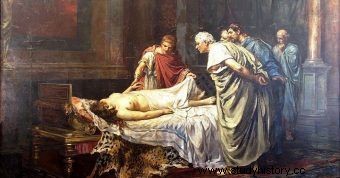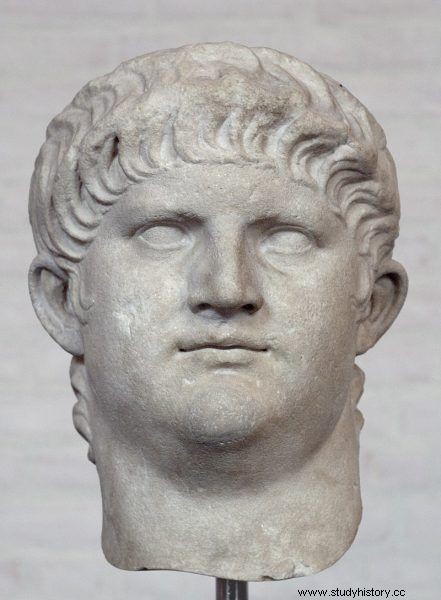He went down in history as a murderous sexual degener who took pleasure in mistreating Christians and set fire to Rome for fun. Overcome by madness, he watched the fire, continuing to sing and play the lyre ... In addition, he killed his mother, brother and two wives, and in his spare time he harassed women. But was Nero really as bad and crazy as they paint him?
At first, nothing seemed to be a catastrophe. The young ruler, ascending the throne in 57 at the age of just 17, seemed a good candidate for emperor. Indeed, the first years of his reign were a time of rather reasonable and responsible governance. Soon, however, everything was about to change ... Robert Fabbri in the volume of the best-selling series about Vespasian The Holy Fire of Rome reports:
After the death of his mother, killed by his order, and the rejection of Seneca's former mentor, who tried to keep the young princeps in the path of dignity and restraint, Nero realized that he could do literally anything.
He killed his mother because she upset him; brother, because he saw a threat in him; and recently a wife, Claudia Octavia, so that Poppaea Sabina could take her place - he even gave the head of her predecessor as a wedding gift to the new empress. Nobody criticized him for these crimes, because there were no such daredevils.

Did Nero deserve the reputation of a madman and cruelty that lingers to this day?
This is how his journey to madness began.
Nero. Conqueror of Christians
The vision of Nero as a depraved tyrant, one of the bloodiest emperors in the history of Rome and a hardened enemy of Christians was perpetuated by Henryk Sienkiewicz in his novel Quo Vadis. But did the ruler really enjoy the persecution of dissenters? Or maybe the writer let his imagination run wild?
From ancient sources emerges (if possible) an even worse portrait of Nero - the oppressor of the followers of the new faith. Tacitus wrote about him:
He chose the scapegoats and punished the depraved infidels with great care (...). Their death was supposed to be grotesque. Dressed in animal skins, they were torn to shreds by dogs, crucified, or set on fire like torches to substitute for daylight. (...) There was a widespread belief that they did not die for the sake of the Empire, but were victims of one man's ruthlessness.
It was supposed to be a punishment for the great fire of Rome in 64 AD (the same one that Nero was later accused of starting). Interestingly, however, it was probably not the ruler who came up with the idea of blaming Christians for the catastrophe. With some of the researchers, he was suggested by his second wife, Poppaea Sabina, who was considered to be a sympathizer of the Jews.
Turning against the Christians later caused Nero with hiccups, but immediately after these events, no one seemed to care too much about the crime. Especially since - as Aleksander Krawczuk describes:"the subject of the greatest interest was the incredible scale of work during the planned expansion of the city and during the construction of a huge complex of imperial palaces".
The indifferent reaction of the subjects does not, however, diminish the emperor's cruelty. Especially since he was also brutal towards his loved ones ...
Lusted Killer
The list of his victims includes, among others Agrippin's despotic mother (whom he had ordered to murder, fearing that he would deprive him of power), as well as his stepbrother Britannicus (also a competitor to the throne) and his first two wives.
With Octavia, with whom he had a purely political bond, he first divorced under the pretext of her sterility and alleged infidelity, then banished her to the island of the prison - Pandateria, to finally order her death. The woman was strangled and her decapitated head was presented by Nero to another chosen one, Poppaea.
And she was not allowed to enjoy life for a long time. Although she gave birth to the ruler his only child - daughter Claudia - she fell victim to his impetuosity. One night, drunk, cheerful with fun, Nero, after returning home, threw his fists at her and tortured her to death. It didn't matter to him that his wife was pregnant again.

Nero's cruelty knew no bounds. The emperor murdered his own mother
He also serially got rid of his political opponents (for example, by forcing them to commit suicide). This was the case, for example, in April 65, when a conspiracy against the emperor was revealed. Aleksander Krawczuk reports:
Dozens or even hundreds of people paid their heads for real or only alleged participation in the conspiracy. Even the praetorian prefect Fenius Rufus was among the convicts. The emperor's former advisor, Seneca, had to commit suicide by openly living, as did his nephew, the poet Lukan.
As the number of corpses and exiled people grew, so did the expressions of joy and loud thanksgiving for miraculously saving the emperor again. April was named Neronius to commemorate the eternal lucky detection of hostile machinations. Coins with appropriate inscriptions were also minted.
This does not mean, however, that the nobles, as well as ordinary Romans, in fact worshiped the cruel ruler. On the contrary - rumors of his alleged sexual deviations were spread, and he was accused of having an incestuous relationship with his mother in his youth (these slanders were perpetuated by Suetonius, who was unfavorable to Nero - the same one who claimed that Nero had deliberately ordered Rome to be set on fire in an act of exaltation, in order to have a suitable background for reciting the epic The Plunder of Troy), and it was also said that he would sneak out of the palace at night to plunder shops, raid passers-by and harass women they meet by chance ...
Unfulfilled artist
The subject of mockery (secret of course) was the artistic flair of the ruler. Nero was convinced of his own incomparable talent. When he committed suicide on June 9, '68, he was said to have said:"What artist is dying in me." In fact, he was a rather poor musician and poet. In the novel by Vespasian. The Holy Fire of Rome Robert Fabbri describes this scene:
After two consecutive chords that shouldn't sound together at all, Nero began a disharmonious lament with a chaotic rhythm and poor rhymes. He continued, line by line, while the elite of Rome listened attentively as befits the lucky ones whom fate had placed in the company of a genius (...).

Nero did not hesitate to sentence people to death
The entire patriciate knew that Nero would not bear the knowledge that anyone thinks badly of him; he wanted to be loved by everyone - and those who did not hide their views, had nothing to look for in his city.
Self-delight was to lead him even to set fire to Rome - just to fulfill his poetic ambitions (or at least so claims the already mentioned author of The Lives of Caesars, Suetonius). The historian Jerzy Ciechanowicz emphasizes, however:
While the fire itself is a historical fact, the presumption that it was Nero who ordered Rome to be set on fire is, of course, a mere fantasy. For many modern historians it is obvious that Nero did not set fire to Rome.
The archaeologist Henry Hurst is of a similar opinion, who believes that Nero could not have commissioned his praetorians to set fire. This is evidenced by the fact that Domus Transitoria was destroyed during the fire - where works of art appreciated by the emperor were located.
Paradoxically, the catastrophe made the ruler finally find an outlet for his artistic endeavors - because at his request the reconstruction of the capital was begun with extraordinary panache. Reborn from its ashes, Rome was an impressive and modern (for that time) city. The gigantic investment did not win Nero's sympathy, however.
His tyranny and cruelty aroused more and more discontent among patricians. Uprisings against the despotic rule of the mad emperor began in subsequent provinces. Eutropius summed it up best when he wrote: "The Roman world cursed him and everyone left at the same time, and the Senate considered him an enemy." Eventually, abandoned by everyone, at the age of only 31, he was forced to commit suicide. Oh, the irony of fate…
Inspiration:
R. Fabbri, Vespasian. Holy fire of Rome , Rebis 2020.
Bibliography:
- S. Duda, Who Set Fire To Rome, "Ale Historia" (accessed:7/28/2020).
- Eutropius, The Brewaria of Roman History, WUW 2010.
- Gajus Suetonius Tranquillus, Lives of Caesars, Book VI, Ossolineum 1987.
- A. Krawczuk, Poczet Roman Emperors, Iskry Publishing House 2004.
- Nero - tyrant and despot about the soul of an artist, PolskieRadio.pl (accessed:28/07/2020).
- Publiusz Corneliusz Tacyt, Dzieła, Czytelnik 2004.
- P. Vandenberg, Neron, Świat Książki
